Using Enterprise Resource Planning Software for School Processes
VerifiedAdded on 2023/06/03
|8
|3057
|244
AI Summary
This study discusses a framework-based polices for managing ERP and a rationale for establishing the framework-based policies in the school where I am the IT manage. ERP requires maintenance regularly and upgrade based on time vendors set for a given ERP version.
Contribute Materials
Your contribution can guide someone’s learning journey. Share your
documents today.
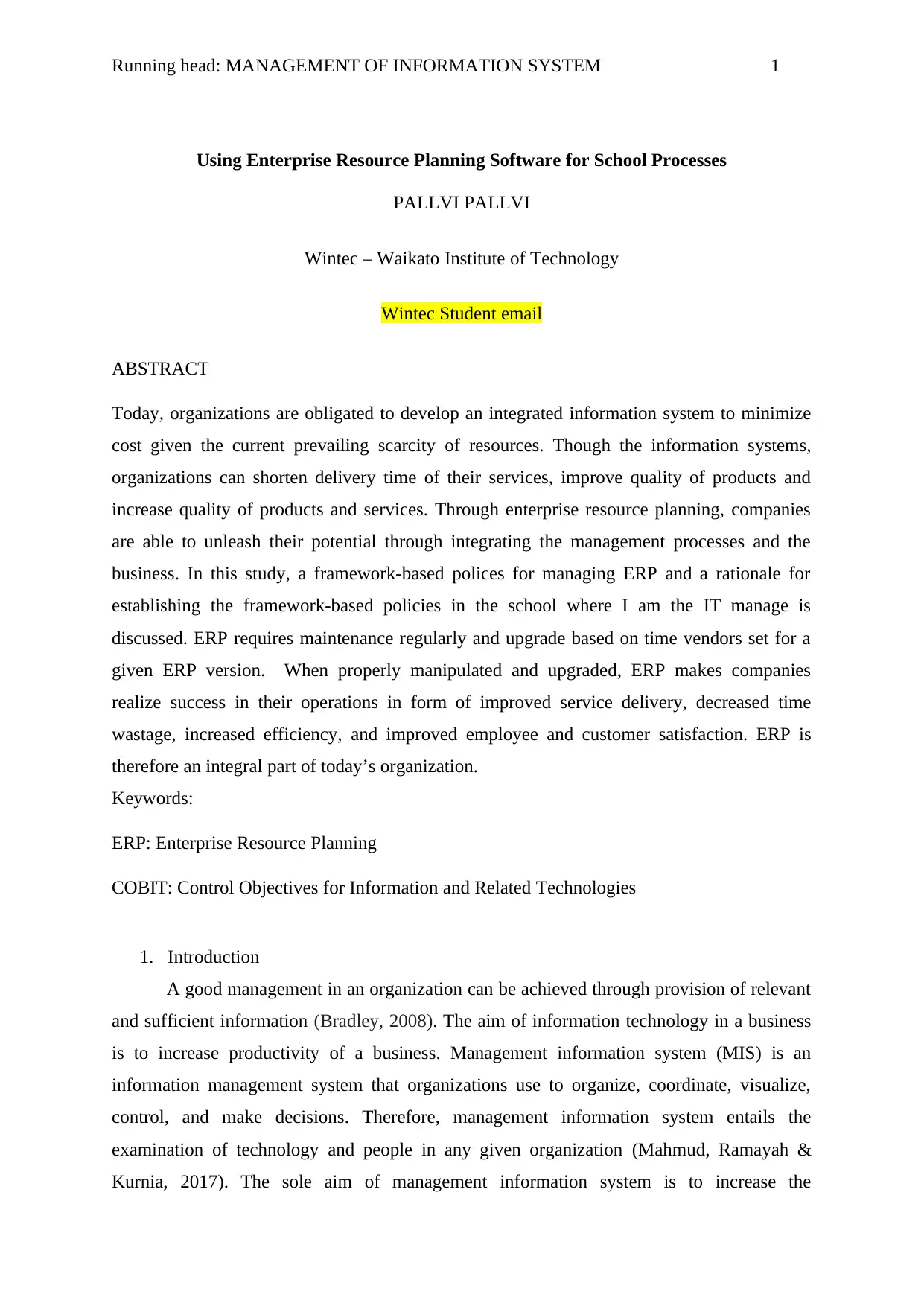
Running head: MANAGEMENT OF INFORMATION SYSTEM 1
Using Enterprise Resource Planning Software for School Processes
PALLVI PALLVI
Wintec – Waikato Institute of Technology
Wintec Student email
ABSTRACT
Today, organizations are obligated to develop an integrated information system to minimize
cost given the current prevailing scarcity of resources. Though the information systems,
organizations can shorten delivery time of their services, improve quality of products and
increase quality of products and services. Through enterprise resource planning, companies
are able to unleash their potential through integrating the management processes and the
business. In this study, a framework-based polices for managing ERP and a rationale for
establishing the framework-based policies in the school where I am the IT manage is
discussed. ERP requires maintenance regularly and upgrade based on time vendors set for a
given ERP version. When properly manipulated and upgraded, ERP makes companies
realize success in their operations in form of improved service delivery, decreased time
wastage, increased efficiency, and improved employee and customer satisfaction. ERP is
therefore an integral part of today’s organization.
Keywords:
ERP: Enterprise Resource Planning
COBIT: Control Objectives for Information and Related Technologies
1. Introduction
A good management in an organization can be achieved through provision of relevant
and sufficient information (Bradley, 2008). The aim of information technology in a business
is to increase productivity of a business. Management information system (MIS) is an
information management system that organizations use to organize, coordinate, visualize,
control, and make decisions. Therefore, management information system entails the
examination of technology and people in any given organization (Mahmud, Ramayah &
Kurnia, 2017). The sole aim of management information system is to increase the
Using Enterprise Resource Planning Software for School Processes
PALLVI PALLVI
Wintec – Waikato Institute of Technology
Wintec Student email
ABSTRACT
Today, organizations are obligated to develop an integrated information system to minimize
cost given the current prevailing scarcity of resources. Though the information systems,
organizations can shorten delivery time of their services, improve quality of products and
increase quality of products and services. Through enterprise resource planning, companies
are able to unleash their potential through integrating the management processes and the
business. In this study, a framework-based polices for managing ERP and a rationale for
establishing the framework-based policies in the school where I am the IT manage is
discussed. ERP requires maintenance regularly and upgrade based on time vendors set for a
given ERP version. When properly manipulated and upgraded, ERP makes companies
realize success in their operations in form of improved service delivery, decreased time
wastage, increased efficiency, and improved employee and customer satisfaction. ERP is
therefore an integral part of today’s organization.
Keywords:
ERP: Enterprise Resource Planning
COBIT: Control Objectives for Information and Related Technologies
1. Introduction
A good management in an organization can be achieved through provision of relevant
and sufficient information (Bradley, 2008). The aim of information technology in a business
is to increase productivity of a business. Management information system (MIS) is an
information management system that organizations use to organize, coordinate, visualize,
control, and make decisions. Therefore, management information system entails the
examination of technology and people in any given organization (Mahmud, Ramayah &
Kurnia, 2017). The sole aim of management information system is to increase the
Secure Best Marks with AI Grader
Need help grading? Try our AI Grader for instant feedback on your assignments.
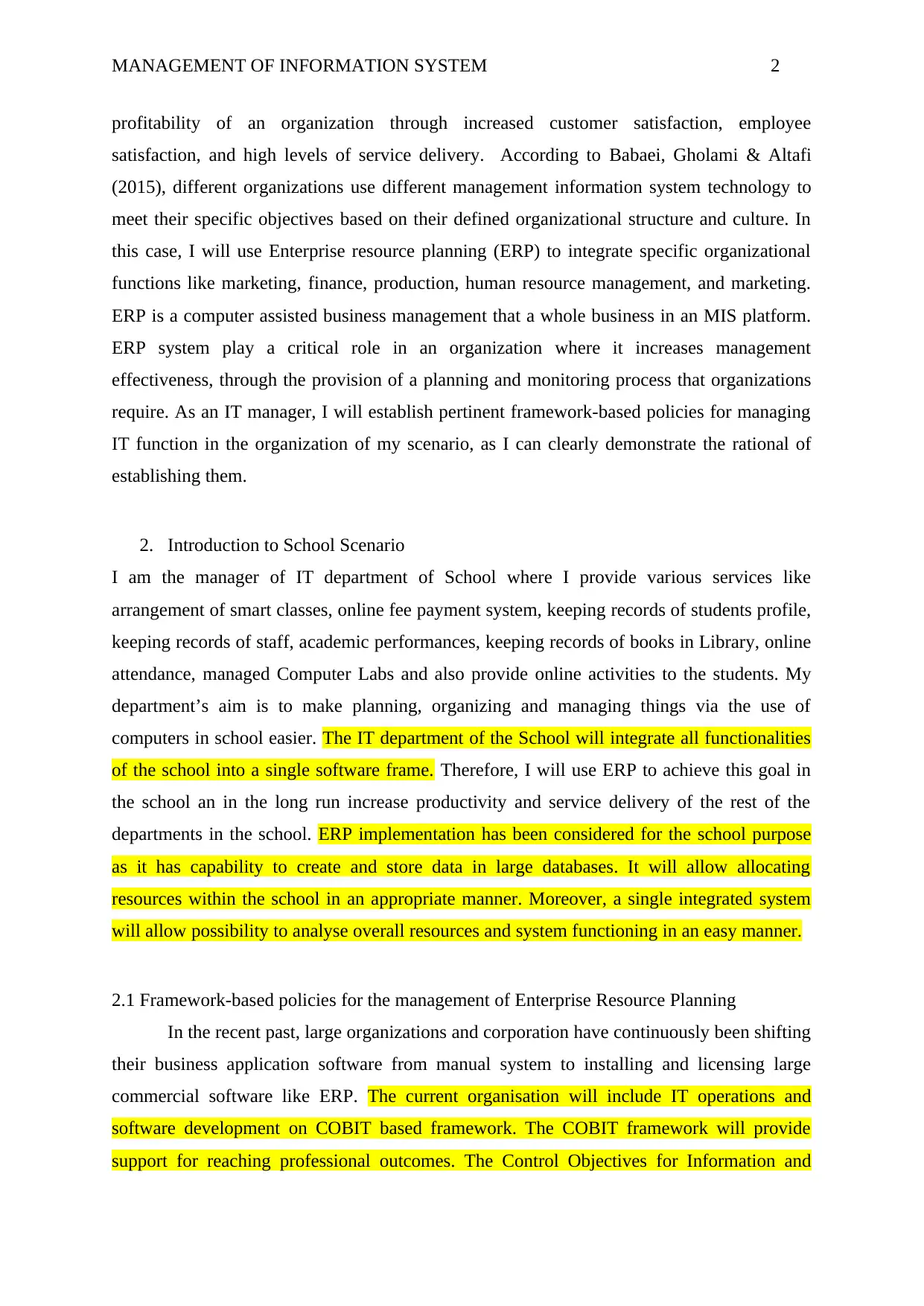
MANAGEMENT OF INFORMATION SYSTEM 2
profitability of an organization through increased customer satisfaction, employee
satisfaction, and high levels of service delivery. According to Babaei, Gholami & Altafi
(2015), different organizations use different management information system technology to
meet their specific objectives based on their defined organizational structure and culture. In
this case, I will use Enterprise resource planning (ERP) to integrate specific organizational
functions like marketing, finance, production, human resource management, and marketing.
ERP is a computer assisted business management that a whole business in an MIS platform.
ERP system play a critical role in an organization where it increases management
effectiveness, through the provision of a planning and monitoring process that organizations
require. As an IT manager, I will establish pertinent framework-based policies for managing
IT function in the organization of my scenario, as I can clearly demonstrate the rational of
establishing them.
2. Introduction to School Scenario
I am the manager of IT department of School where I provide various services like
arrangement of smart classes, online fee payment system, keeping records of students profile,
keeping records of staff, academic performances, keeping records of books in Library, online
attendance, managed Computer Labs and also provide online activities to the students. My
department’s aim is to make planning, organizing and managing things via the use of
computers in school easier. The IT department of the School will integrate all functionalities
of the school into a single software frame. Therefore, I will use ERP to achieve this goal in
the school an in the long run increase productivity and service delivery of the rest of the
departments in the school. ERP implementation has been considered for the school purpose
as it has capability to create and store data in large databases. It will allow allocating
resources within the school in an appropriate manner. Moreover, a single integrated system
will allow possibility to analyse overall resources and system functioning in an easy manner.
2.1 Framework-based policies for the management of Enterprise Resource Planning
In the recent past, large organizations and corporation have continuously been shifting
their business application software from manual system to installing and licensing large
commercial software like ERP. The current organisation will include IT operations and
software development on COBIT based framework. The COBIT framework will provide
support for reaching professional outcomes. The Control Objectives for Information and
profitability of an organization through increased customer satisfaction, employee
satisfaction, and high levels of service delivery. According to Babaei, Gholami & Altafi
(2015), different organizations use different management information system technology to
meet their specific objectives based on their defined organizational structure and culture. In
this case, I will use Enterprise resource planning (ERP) to integrate specific organizational
functions like marketing, finance, production, human resource management, and marketing.
ERP is a computer assisted business management that a whole business in an MIS platform.
ERP system play a critical role in an organization where it increases management
effectiveness, through the provision of a planning and monitoring process that organizations
require. As an IT manager, I will establish pertinent framework-based policies for managing
IT function in the organization of my scenario, as I can clearly demonstrate the rational of
establishing them.
2. Introduction to School Scenario
I am the manager of IT department of School where I provide various services like
arrangement of smart classes, online fee payment system, keeping records of students profile,
keeping records of staff, academic performances, keeping records of books in Library, online
attendance, managed Computer Labs and also provide online activities to the students. My
department’s aim is to make planning, organizing and managing things via the use of
computers in school easier. The IT department of the School will integrate all functionalities
of the school into a single software frame. Therefore, I will use ERP to achieve this goal in
the school an in the long run increase productivity and service delivery of the rest of the
departments in the school. ERP implementation has been considered for the school purpose
as it has capability to create and store data in large databases. It will allow allocating
resources within the school in an appropriate manner. Moreover, a single integrated system
will allow possibility to analyse overall resources and system functioning in an easy manner.
2.1 Framework-based policies for the management of Enterprise Resource Planning
In the recent past, large organizations and corporation have continuously been shifting
their business application software from manual system to installing and licensing large
commercial software like ERP. The current organisation will include IT operations and
software development on COBIT based framework. The COBIT framework will provide
support for reaching professional outcomes. The Control Objectives for Information and
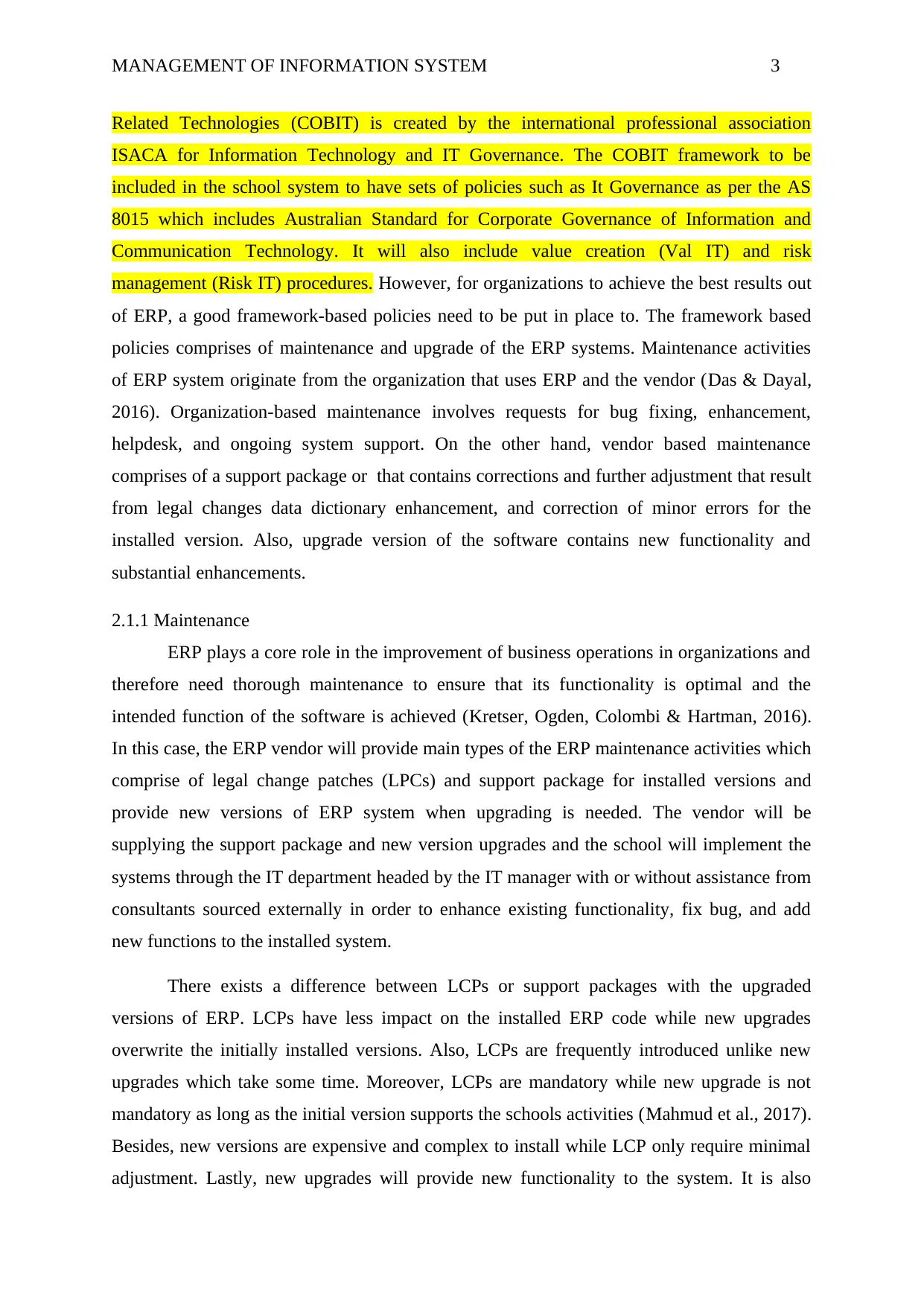
MANAGEMENT OF INFORMATION SYSTEM 3
Related Technologies (COBIT) is created by the international professional association
ISACA for Information Technology and IT Governance. The COBIT framework to be
included in the school system to have sets of policies such as It Governance as per the AS
8015 which includes Australian Standard for Corporate Governance of Information and
Communication Technology. It will also include value creation (Val IT) and risk
management (Risk IT) procedures. However, for organizations to achieve the best results out
of ERP, a good framework-based policies need to be put in place to. The framework based
policies comprises of maintenance and upgrade of the ERP systems. Maintenance activities
of ERP system originate from the organization that uses ERP and the vendor (Das & Dayal,
2016). Organization-based maintenance involves requests for bug fixing, enhancement,
helpdesk, and ongoing system support. On the other hand, vendor based maintenance
comprises of a support package or that contains corrections and further adjustment that result
from legal changes data dictionary enhancement, and correction of minor errors for the
installed version. Also, upgrade version of the software contains new functionality and
substantial enhancements.
2.1.1 Maintenance
ERP plays a core role in the improvement of business operations in organizations and
therefore need thorough maintenance to ensure that its functionality is optimal and the
intended function of the software is achieved (Kretser, Ogden, Colombi & Hartman, 2016).
In this case, the ERP vendor will provide main types of the ERP maintenance activities which
comprise of legal change patches (LPCs) and support package for installed versions and
provide new versions of ERP system when upgrading is needed. The vendor will be
supplying the support package and new version upgrades and the school will implement the
systems through the IT department headed by the IT manager with or without assistance from
consultants sourced externally in order to enhance existing functionality, fix bug, and add
new functions to the installed system.
There exists a difference between LCPs or support packages with the upgraded
versions of ERP. LCPs have less impact on the installed ERP code while new upgrades
overwrite the initially installed versions. Also, LCPs are frequently introduced unlike new
upgrades which take some time. Moreover, LCPs are mandatory while new upgrade is not
mandatory as long as the initial version supports the schools activities (Mahmud et al., 2017).
Besides, new versions are expensive and complex to install while LCP only require minimal
adjustment. Lastly, new upgrades will provide new functionality to the system. It is also
Related Technologies (COBIT) is created by the international professional association
ISACA for Information Technology and IT Governance. The COBIT framework to be
included in the school system to have sets of policies such as It Governance as per the AS
8015 which includes Australian Standard for Corporate Governance of Information and
Communication Technology. It will also include value creation (Val IT) and risk
management (Risk IT) procedures. However, for organizations to achieve the best results out
of ERP, a good framework-based policies need to be put in place to. The framework based
policies comprises of maintenance and upgrade of the ERP systems. Maintenance activities
of ERP system originate from the organization that uses ERP and the vendor (Das & Dayal,
2016). Organization-based maintenance involves requests for bug fixing, enhancement,
helpdesk, and ongoing system support. On the other hand, vendor based maintenance
comprises of a support package or that contains corrections and further adjustment that result
from legal changes data dictionary enhancement, and correction of minor errors for the
installed version. Also, upgrade version of the software contains new functionality and
substantial enhancements.
2.1.1 Maintenance
ERP plays a core role in the improvement of business operations in organizations and
therefore need thorough maintenance to ensure that its functionality is optimal and the
intended function of the software is achieved (Kretser, Ogden, Colombi & Hartman, 2016).
In this case, the ERP vendor will provide main types of the ERP maintenance activities which
comprise of legal change patches (LPCs) and support package for installed versions and
provide new versions of ERP system when upgrading is needed. The vendor will be
supplying the support package and new version upgrades and the school will implement the
systems through the IT department headed by the IT manager with or without assistance from
consultants sourced externally in order to enhance existing functionality, fix bug, and add
new functions to the installed system.
There exists a difference between LCPs or support packages with the upgraded
versions of ERP. LCPs have less impact on the installed ERP code while new upgrades
overwrite the initially installed versions. Also, LCPs are frequently introduced unlike new
upgrades which take some time. Moreover, LCPs are mandatory while new upgrade is not
mandatory as long as the initial version supports the schools activities (Mahmud et al., 2017).
Besides, new versions are expensive and complex to install while LCP only require minimal
adjustment. Lastly, new upgrades will provide new functionality to the system. It is also
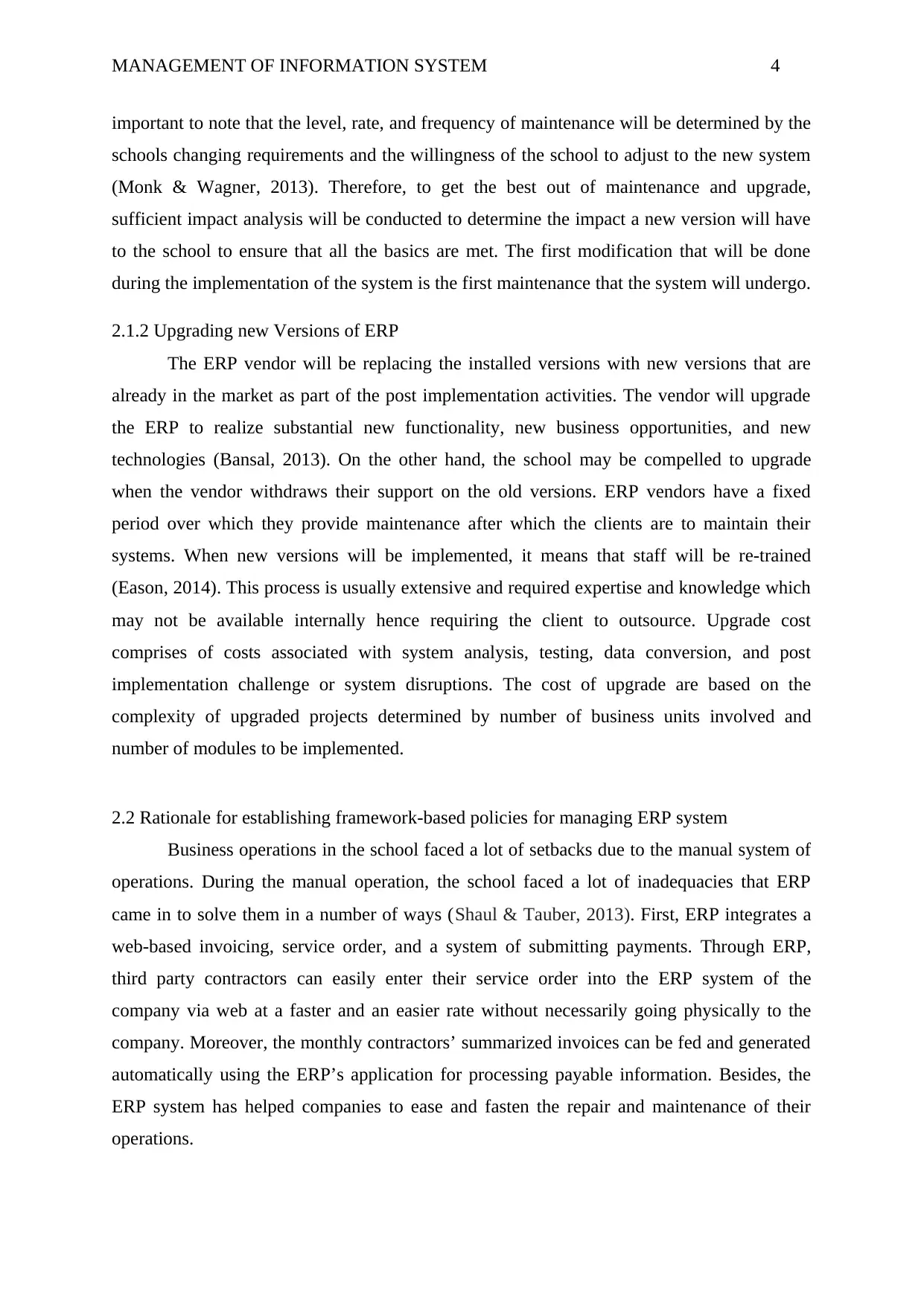
MANAGEMENT OF INFORMATION SYSTEM 4
important to note that the level, rate, and frequency of maintenance will be determined by the
schools changing requirements and the willingness of the school to adjust to the new system
(Monk & Wagner, 2013). Therefore, to get the best out of maintenance and upgrade,
sufficient impact analysis will be conducted to determine the impact a new version will have
to the school to ensure that all the basics are met. The first modification that will be done
during the implementation of the system is the first maintenance that the system will undergo.
2.1.2 Upgrading new Versions of ERP
The ERP vendor will be replacing the installed versions with new versions that are
already in the market as part of the post implementation activities. The vendor will upgrade
the ERP to realize substantial new functionality, new business opportunities, and new
technologies (Bansal, 2013). On the other hand, the school may be compelled to upgrade
when the vendor withdraws their support on the old versions. ERP vendors have a fixed
period over which they provide maintenance after which the clients are to maintain their
systems. When new versions will be implemented, it means that staff will be re-trained
(Eason, 2014). This process is usually extensive and required expertise and knowledge which
may not be available internally hence requiring the client to outsource. Upgrade cost
comprises of costs associated with system analysis, testing, data conversion, and post
implementation challenge or system disruptions. The cost of upgrade are based on the
complexity of upgraded projects determined by number of business units involved and
number of modules to be implemented.
2.2 Rationale for establishing framework-based policies for managing ERP system
Business operations in the school faced a lot of setbacks due to the manual system of
operations. During the manual operation, the school faced a lot of inadequacies that ERP
came in to solve them in a number of ways (Shaul & Tauber, 2013). First, ERP integrates a
web-based invoicing, service order, and a system of submitting payments. Through ERP,
third party contractors can easily enter their service order into the ERP system of the
company via web at a faster and an easier rate without necessarily going physically to the
company. Moreover, the monthly contractors’ summarized invoices can be fed and generated
automatically using the ERP’s application for processing payable information. Besides, the
ERP system has helped companies to ease and fasten the repair and maintenance of their
operations.
important to note that the level, rate, and frequency of maintenance will be determined by the
schools changing requirements and the willingness of the school to adjust to the new system
(Monk & Wagner, 2013). Therefore, to get the best out of maintenance and upgrade,
sufficient impact analysis will be conducted to determine the impact a new version will have
to the school to ensure that all the basics are met. The first modification that will be done
during the implementation of the system is the first maintenance that the system will undergo.
2.1.2 Upgrading new Versions of ERP
The ERP vendor will be replacing the installed versions with new versions that are
already in the market as part of the post implementation activities. The vendor will upgrade
the ERP to realize substantial new functionality, new business opportunities, and new
technologies (Bansal, 2013). On the other hand, the school may be compelled to upgrade
when the vendor withdraws their support on the old versions. ERP vendors have a fixed
period over which they provide maintenance after which the clients are to maintain their
systems. When new versions will be implemented, it means that staff will be re-trained
(Eason, 2014). This process is usually extensive and required expertise and knowledge which
may not be available internally hence requiring the client to outsource. Upgrade cost
comprises of costs associated with system analysis, testing, data conversion, and post
implementation challenge or system disruptions. The cost of upgrade are based on the
complexity of upgraded projects determined by number of business units involved and
number of modules to be implemented.
2.2 Rationale for establishing framework-based policies for managing ERP system
Business operations in the school faced a lot of setbacks due to the manual system of
operations. During the manual operation, the school faced a lot of inadequacies that ERP
came in to solve them in a number of ways (Shaul & Tauber, 2013). First, ERP integrates a
web-based invoicing, service order, and a system of submitting payments. Through ERP,
third party contractors can easily enter their service order into the ERP system of the
company via web at a faster and an easier rate without necessarily going physically to the
company. Moreover, the monthly contractors’ summarized invoices can be fed and generated
automatically using the ERP’s application for processing payable information. Besides, the
ERP system has helped companies to ease and fasten the repair and maintenance of their
operations.
Secure Best Marks with AI Grader
Need help grading? Try our AI Grader for instant feedback on your assignments.
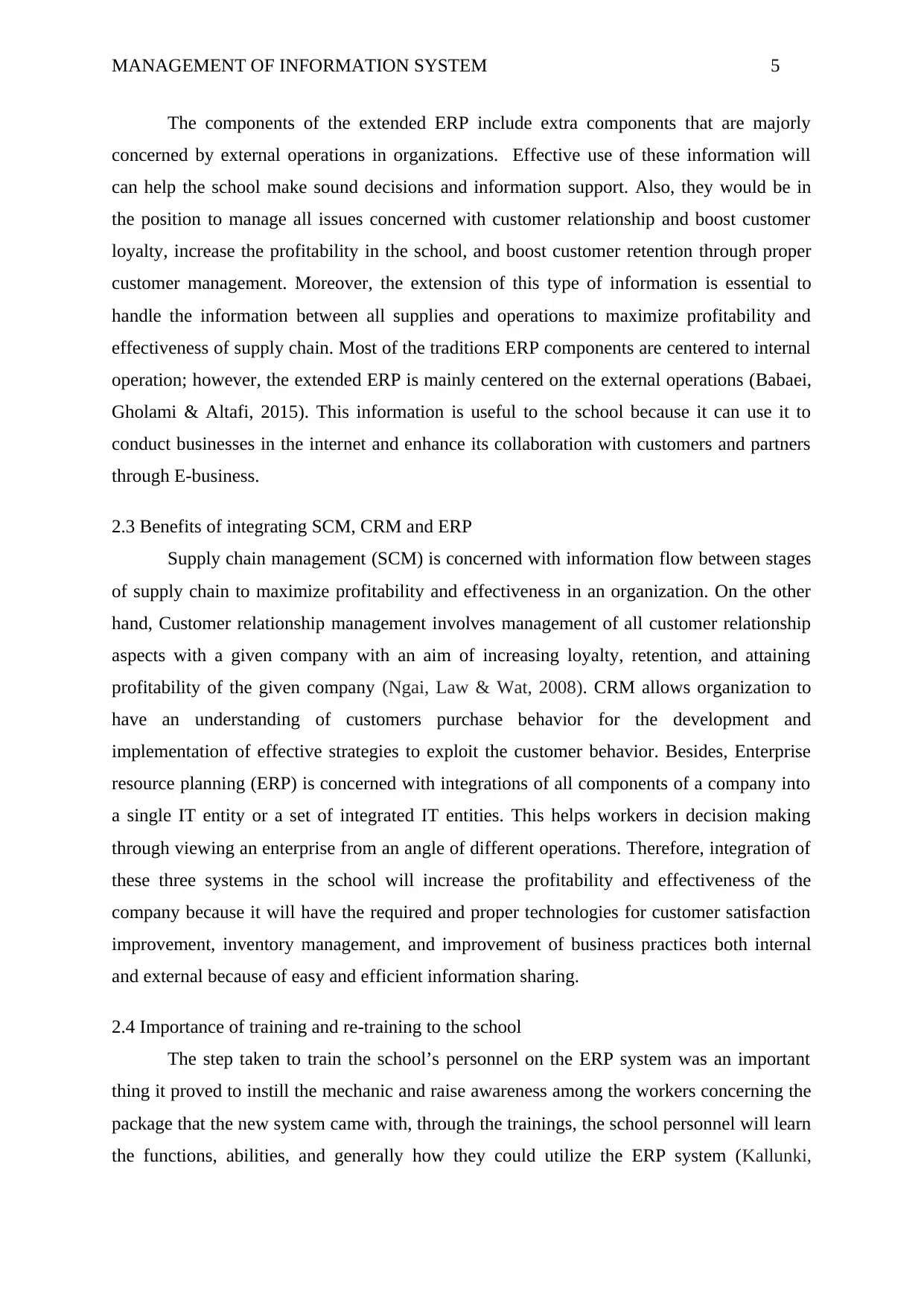
MANAGEMENT OF INFORMATION SYSTEM 5
The components of the extended ERP include extra components that are majorly
concerned by external operations in organizations. Effective use of these information will
can help the school make sound decisions and information support. Also, they would be in
the position to manage all issues concerned with customer relationship and boost customer
loyalty, increase the profitability in the school, and boost customer retention through proper
customer management. Moreover, the extension of this type of information is essential to
handle the information between all supplies and operations to maximize profitability and
effectiveness of supply chain. Most of the traditions ERP components are centered to internal
operation; however, the extended ERP is mainly centered on the external operations (Babaei,
Gholami & Altafi, 2015). This information is useful to the school because it can use it to
conduct businesses in the internet and enhance its collaboration with customers and partners
through E-business.
2.3 Benefits of integrating SCM, CRM and ERP
Supply chain management (SCM) is concerned with information flow between stages
of supply chain to maximize profitability and effectiveness in an organization. On the other
hand, Customer relationship management involves management of all customer relationship
aspects with a given company with an aim of increasing loyalty, retention, and attaining
profitability of the given company (Ngai, Law & Wat, 2008). CRM allows organization to
have an understanding of customers purchase behavior for the development and
implementation of effective strategies to exploit the customer behavior. Besides, Enterprise
resource planning (ERP) is concerned with integrations of all components of a company into
a single IT entity or a set of integrated IT entities. This helps workers in decision making
through viewing an enterprise from an angle of different operations. Therefore, integration of
these three systems in the school will increase the profitability and effectiveness of the
company because it will have the required and proper technologies for customer satisfaction
improvement, inventory management, and improvement of business practices both internal
and external because of easy and efficient information sharing.
2.4 Importance of training and re-training to the school
The step taken to train the school’s personnel on the ERP system was an important
thing it proved to instill the mechanic and raise awareness among the workers concerning the
package that the new system came with, through the trainings, the school personnel will learn
the functions, abilities, and generally how they could utilize the ERP system (Kallunki,
The components of the extended ERP include extra components that are majorly
concerned by external operations in organizations. Effective use of these information will
can help the school make sound decisions and information support. Also, they would be in
the position to manage all issues concerned with customer relationship and boost customer
loyalty, increase the profitability in the school, and boost customer retention through proper
customer management. Moreover, the extension of this type of information is essential to
handle the information between all supplies and operations to maximize profitability and
effectiveness of supply chain. Most of the traditions ERP components are centered to internal
operation; however, the extended ERP is mainly centered on the external operations (Babaei,
Gholami & Altafi, 2015). This information is useful to the school because it can use it to
conduct businesses in the internet and enhance its collaboration with customers and partners
through E-business.
2.3 Benefits of integrating SCM, CRM and ERP
Supply chain management (SCM) is concerned with information flow between stages
of supply chain to maximize profitability and effectiveness in an organization. On the other
hand, Customer relationship management involves management of all customer relationship
aspects with a given company with an aim of increasing loyalty, retention, and attaining
profitability of the given company (Ngai, Law & Wat, 2008). CRM allows organization to
have an understanding of customers purchase behavior for the development and
implementation of effective strategies to exploit the customer behavior. Besides, Enterprise
resource planning (ERP) is concerned with integrations of all components of a company into
a single IT entity or a set of integrated IT entities. This helps workers in decision making
through viewing an enterprise from an angle of different operations. Therefore, integration of
these three systems in the school will increase the profitability and effectiveness of the
company because it will have the required and proper technologies for customer satisfaction
improvement, inventory management, and improvement of business practices both internal
and external because of easy and efficient information sharing.
2.4 Importance of training and re-training to the school
The step taken to train the school’s personnel on the ERP system was an important
thing it proved to instill the mechanic and raise awareness among the workers concerning the
package that the new system came with, through the trainings, the school personnel will learn
the functions, abilities, and generally how they could utilize the ERP system (Kallunki,
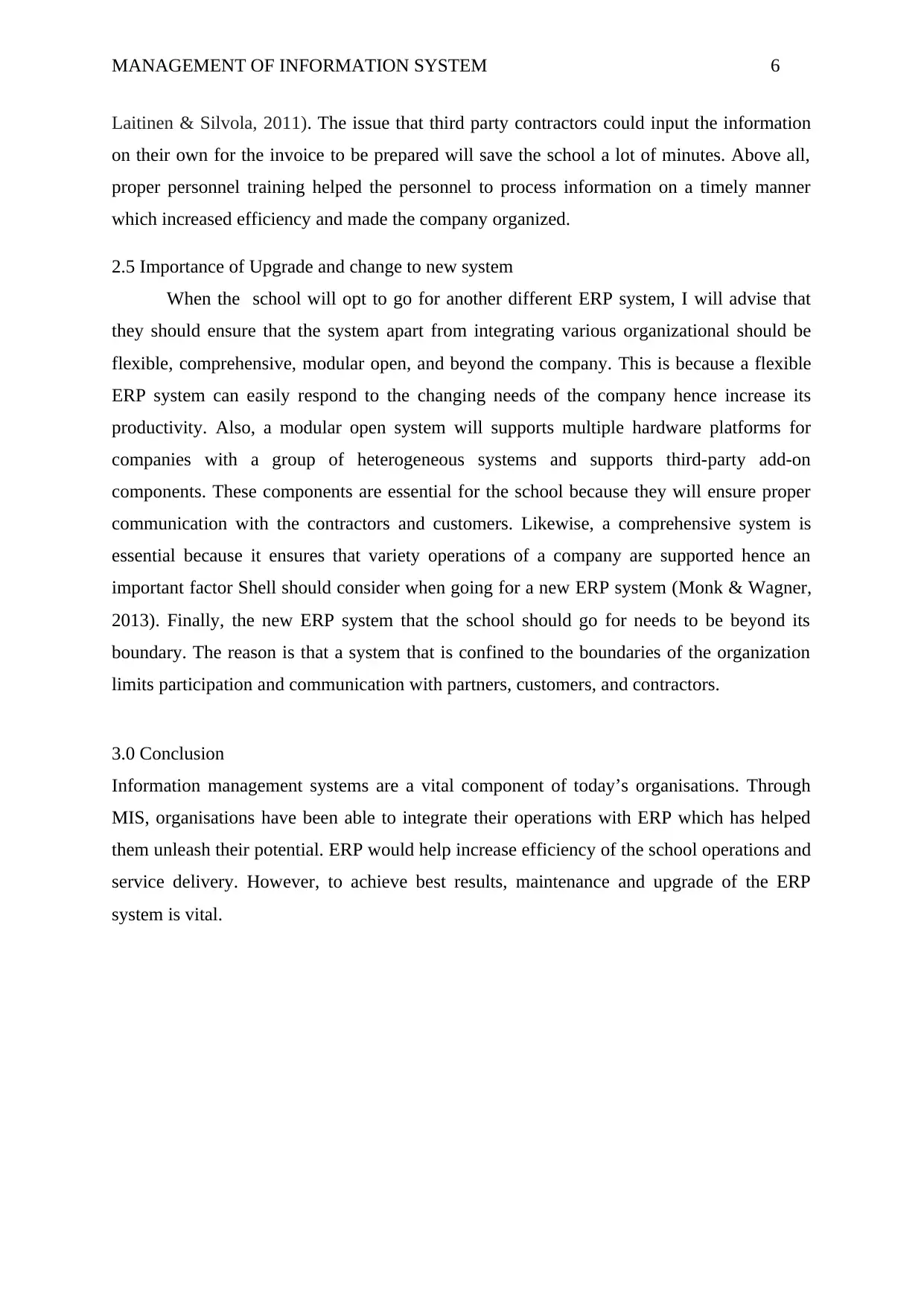
MANAGEMENT OF INFORMATION SYSTEM 6
Laitinen & Silvola, 2011). The issue that third party contractors could input the information
on their own for the invoice to be prepared will save the school a lot of minutes. Above all,
proper personnel training helped the personnel to process information on a timely manner
which increased efficiency and made the company organized.
2.5 Importance of Upgrade and change to new system
When the school will opt to go for another different ERP system, I will advise that
they should ensure that the system apart from integrating various organizational should be
flexible, comprehensive, modular open, and beyond the company. This is because a flexible
ERP system can easily respond to the changing needs of the company hence increase its
productivity. Also, a modular open system will supports multiple hardware platforms for
companies with a group of heterogeneous systems and supports third-party add-on
components. These components are essential for the school because they will ensure proper
communication with the contractors and customers. Likewise, a comprehensive system is
essential because it ensures that variety operations of a company are supported hence an
important factor Shell should consider when going for a new ERP system (Monk & Wagner,
2013). Finally, the new ERP system that the school should go for needs to be beyond its
boundary. The reason is that a system that is confined to the boundaries of the organization
limits participation and communication with partners, customers, and contractors.
3.0 Conclusion
Information management systems are a vital component of today’s organisations. Through
MIS, organisations have been able to integrate their operations with ERP which has helped
them unleash their potential. ERP would help increase efficiency of the school operations and
service delivery. However, to achieve best results, maintenance and upgrade of the ERP
system is vital.
Laitinen & Silvola, 2011). The issue that third party contractors could input the information
on their own for the invoice to be prepared will save the school a lot of minutes. Above all,
proper personnel training helped the personnel to process information on a timely manner
which increased efficiency and made the company organized.
2.5 Importance of Upgrade and change to new system
When the school will opt to go for another different ERP system, I will advise that
they should ensure that the system apart from integrating various organizational should be
flexible, comprehensive, modular open, and beyond the company. This is because a flexible
ERP system can easily respond to the changing needs of the company hence increase its
productivity. Also, a modular open system will supports multiple hardware platforms for
companies with a group of heterogeneous systems and supports third-party add-on
components. These components are essential for the school because they will ensure proper
communication with the contractors and customers. Likewise, a comprehensive system is
essential because it ensures that variety operations of a company are supported hence an
important factor Shell should consider when going for a new ERP system (Monk & Wagner,
2013). Finally, the new ERP system that the school should go for needs to be beyond its
boundary. The reason is that a system that is confined to the boundaries of the organization
limits participation and communication with partners, customers, and contractors.
3.0 Conclusion
Information management systems are a vital component of today’s organisations. Through
MIS, organisations have been able to integrate their operations with ERP which has helped
them unleash their potential. ERP would help increase efficiency of the school operations and
service delivery. However, to achieve best results, maintenance and upgrade of the ERP
system is vital.
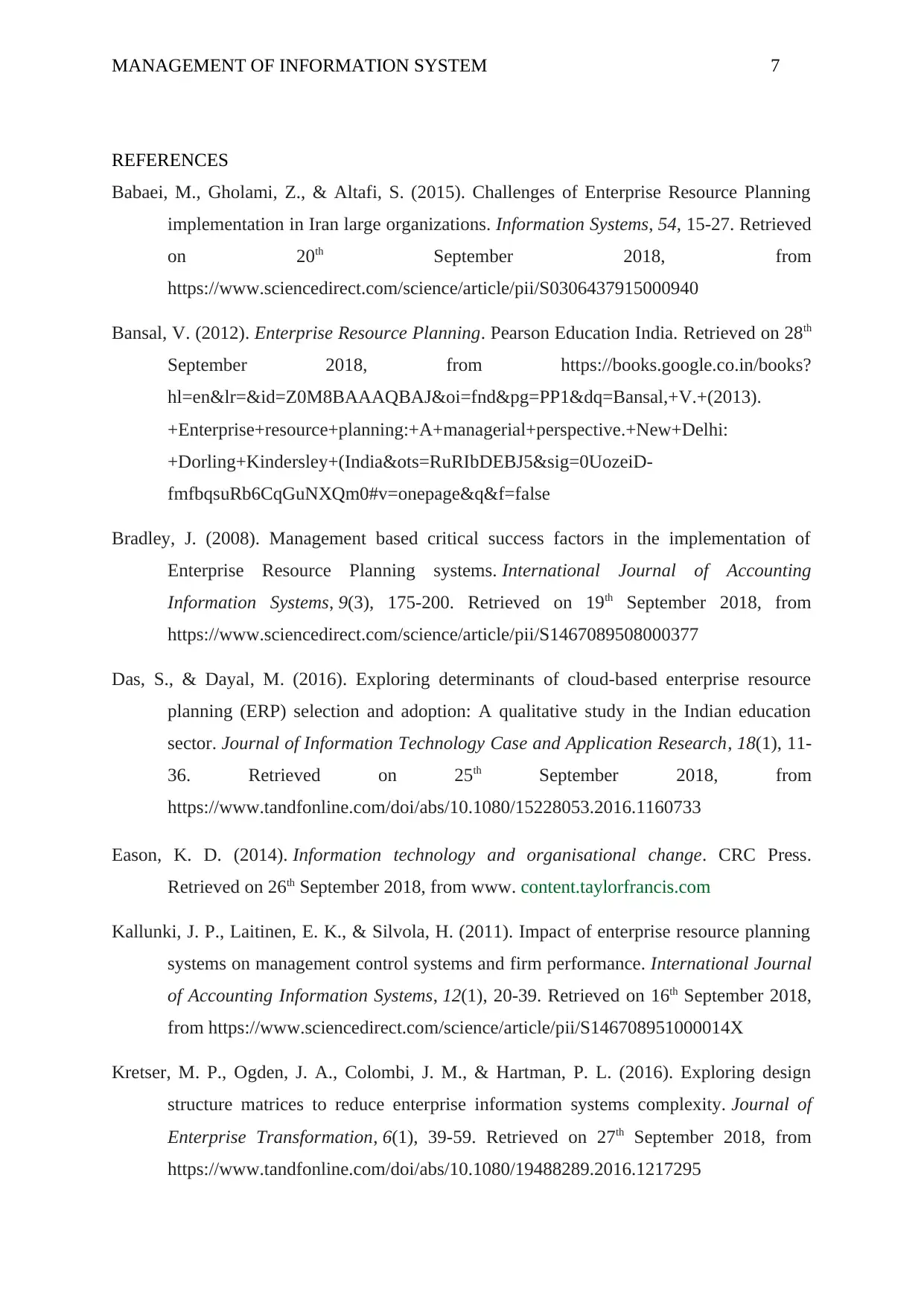
MANAGEMENT OF INFORMATION SYSTEM 7
REFERENCES
Babaei, M., Gholami, Z., & Altafi, S. (2015). Challenges of Enterprise Resource Planning
implementation in Iran large organizations. Information Systems, 54, 15-27. Retrieved
on 20th September 2018, from
https://www.sciencedirect.com/science/article/pii/S0306437915000940
Bansal, V. (2012). Enterprise Resource Planning. Pearson Education India. Retrieved on 28th
September 2018, from https://books.google.co.in/books?
hl=en&lr=&id=Z0M8BAAAQBAJ&oi=fnd&pg=PP1&dq=Bansal,+V.+(2013).
+Enterprise+resource+planning:+A+managerial+perspective.+New+Delhi:
+Dorling+Kindersley+(India&ots=RuRIbDEBJ5&sig=0UozeiD-
fmfbqsuRb6CqGuNXQm0#v=onepage&q&f=false
Bradley, J. (2008). Management based critical success factors in the implementation of
Enterprise Resource Planning systems. International Journal of Accounting
Information Systems, 9(3), 175-200. Retrieved on 19th September 2018, from
https://www.sciencedirect.com/science/article/pii/S1467089508000377
Das, S., & Dayal, M. (2016). Exploring determinants of cloud-based enterprise resource
planning (ERP) selection and adoption: A qualitative study in the Indian education
sector. Journal of Information Technology Case and Application Research, 18(1), 11-
36. Retrieved on 25th September 2018, from
https://www.tandfonline.com/doi/abs/10.1080/15228053.2016.1160733
Eason, K. D. (2014). Information technology and organisational change. CRC Press.
Retrieved on 26th September 2018, from www. content.taylorfrancis.com
Kallunki, J. P., Laitinen, E. K., & Silvola, H. (2011). Impact of enterprise resource planning
systems on management control systems and firm performance. International Journal
of Accounting Information Systems, 12(1), 20-39. Retrieved on 16th September 2018,
from https://www.sciencedirect.com/science/article/pii/S146708951000014X
Kretser, M. P., Ogden, J. A., Colombi, J. M., & Hartman, P. L. (2016). Exploring design
structure matrices to reduce enterprise information systems complexity. Journal of
Enterprise Transformation, 6(1), 39-59. Retrieved on 27th September 2018, from
https://www.tandfonline.com/doi/abs/10.1080/19488289.2016.1217295
REFERENCES
Babaei, M., Gholami, Z., & Altafi, S. (2015). Challenges of Enterprise Resource Planning
implementation in Iran large organizations. Information Systems, 54, 15-27. Retrieved
on 20th September 2018, from
https://www.sciencedirect.com/science/article/pii/S0306437915000940
Bansal, V. (2012). Enterprise Resource Planning. Pearson Education India. Retrieved on 28th
September 2018, from https://books.google.co.in/books?
hl=en&lr=&id=Z0M8BAAAQBAJ&oi=fnd&pg=PP1&dq=Bansal,+V.+(2013).
+Enterprise+resource+planning:+A+managerial+perspective.+New+Delhi:
+Dorling+Kindersley+(India&ots=RuRIbDEBJ5&sig=0UozeiD-
fmfbqsuRb6CqGuNXQm0#v=onepage&q&f=false
Bradley, J. (2008). Management based critical success factors in the implementation of
Enterprise Resource Planning systems. International Journal of Accounting
Information Systems, 9(3), 175-200. Retrieved on 19th September 2018, from
https://www.sciencedirect.com/science/article/pii/S1467089508000377
Das, S., & Dayal, M. (2016). Exploring determinants of cloud-based enterprise resource
planning (ERP) selection and adoption: A qualitative study in the Indian education
sector. Journal of Information Technology Case and Application Research, 18(1), 11-
36. Retrieved on 25th September 2018, from
https://www.tandfonline.com/doi/abs/10.1080/15228053.2016.1160733
Eason, K. D. (2014). Information technology and organisational change. CRC Press.
Retrieved on 26th September 2018, from www. content.taylorfrancis.com
Kallunki, J. P., Laitinen, E. K., & Silvola, H. (2011). Impact of enterprise resource planning
systems on management control systems and firm performance. International Journal
of Accounting Information Systems, 12(1), 20-39. Retrieved on 16th September 2018,
from https://www.sciencedirect.com/science/article/pii/S146708951000014X
Kretser, M. P., Ogden, J. A., Colombi, J. M., & Hartman, P. L. (2016). Exploring design
structure matrices to reduce enterprise information systems complexity. Journal of
Enterprise Transformation, 6(1), 39-59. Retrieved on 27th September 2018, from
https://www.tandfonline.com/doi/abs/10.1080/19488289.2016.1217295
Paraphrase This Document
Need a fresh take? Get an instant paraphrase of this document with our AI Paraphraser
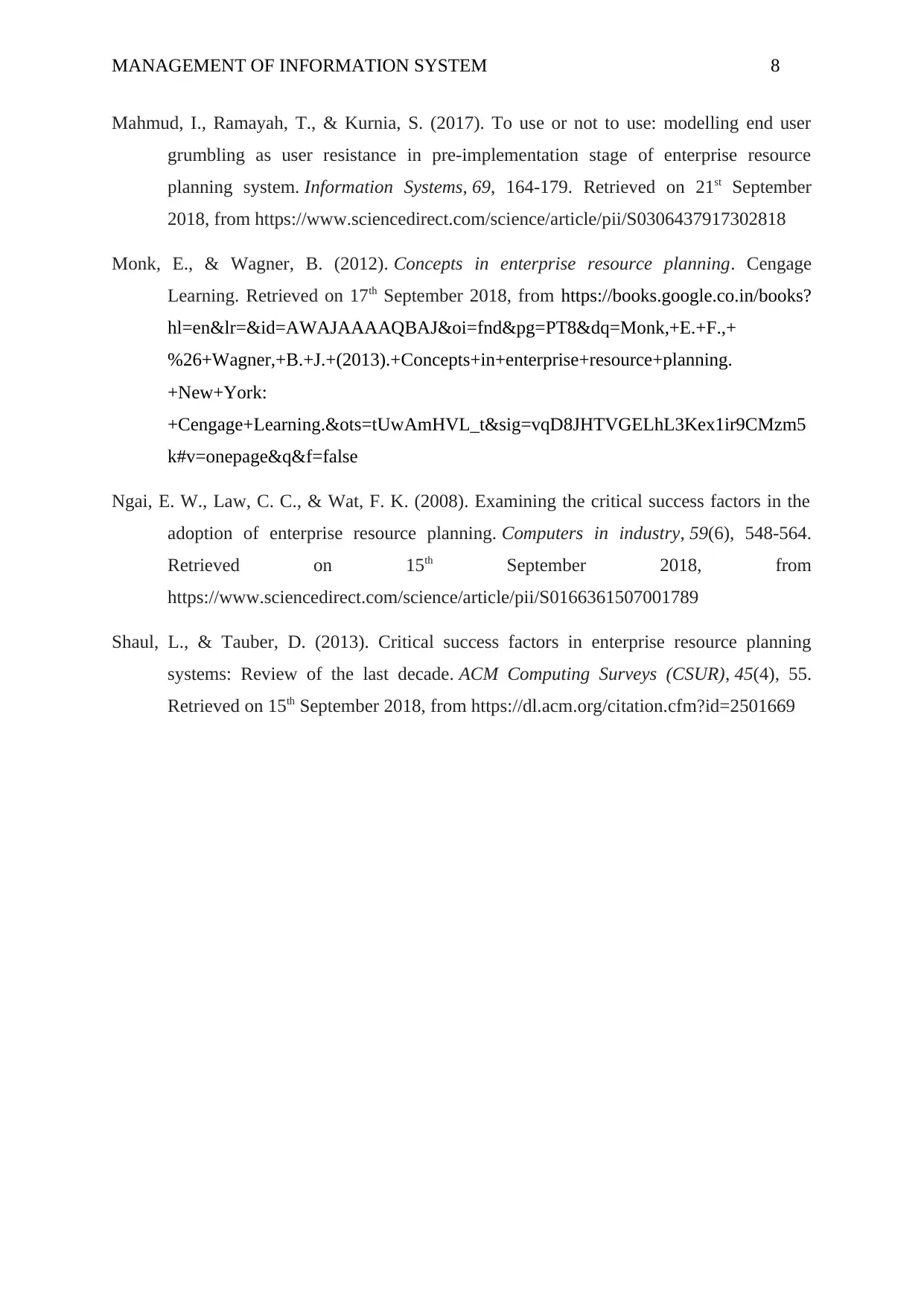
MANAGEMENT OF INFORMATION SYSTEM 8
Mahmud, I., Ramayah, T., & Kurnia, S. (2017). To use or not to use: modelling end user
grumbling as user resistance in pre-implementation stage of enterprise resource
planning system. Information Systems, 69, 164-179. Retrieved on 21st September
2018, from https://www.sciencedirect.com/science/article/pii/S0306437917302818
Monk, E., & Wagner, B. (2012). Concepts in enterprise resource planning. Cengage
Learning. Retrieved on 17th September 2018, from https://books.google.co.in/books?
hl=en&lr=&id=AWAJAAAAQBAJ&oi=fnd&pg=PT8&dq=Monk,+E.+F.,+
%26+Wagner,+B.+J.+(2013).+Concepts+in+enterprise+resource+planning.
+New+York:
+Cengage+Learning.&ots=tUwAmHVL_t&sig=vqD8JHTVGELhL3Kex1ir9CMzm5
k#v=onepage&q&f=false
Ngai, E. W., Law, C. C., & Wat, F. K. (2008). Examining the critical success factors in the
adoption of enterprise resource planning. Computers in industry, 59(6), 548-564.
Retrieved on 15th September 2018, from
https://www.sciencedirect.com/science/article/pii/S0166361507001789
Shaul, L., & Tauber, D. (2013). Critical success factors in enterprise resource planning
systems: Review of the last decade. ACM Computing Surveys (CSUR), 45(4), 55.
Retrieved on 15th September 2018, from https://dl.acm.org/citation.cfm?id=2501669
Mahmud, I., Ramayah, T., & Kurnia, S. (2017). To use or not to use: modelling end user
grumbling as user resistance in pre-implementation stage of enterprise resource
planning system. Information Systems, 69, 164-179. Retrieved on 21st September
2018, from https://www.sciencedirect.com/science/article/pii/S0306437917302818
Monk, E., & Wagner, B. (2012). Concepts in enterprise resource planning. Cengage
Learning. Retrieved on 17th September 2018, from https://books.google.co.in/books?
hl=en&lr=&id=AWAJAAAAQBAJ&oi=fnd&pg=PT8&dq=Monk,+E.+F.,+
%26+Wagner,+B.+J.+(2013).+Concepts+in+enterprise+resource+planning.
+New+York:
+Cengage+Learning.&ots=tUwAmHVL_t&sig=vqD8JHTVGELhL3Kex1ir9CMzm5
k#v=onepage&q&f=false
Ngai, E. W., Law, C. C., & Wat, F. K. (2008). Examining the critical success factors in the
adoption of enterprise resource planning. Computers in industry, 59(6), 548-564.
Retrieved on 15th September 2018, from
https://www.sciencedirect.com/science/article/pii/S0166361507001789
Shaul, L., & Tauber, D. (2013). Critical success factors in enterprise resource planning
systems: Review of the last decade. ACM Computing Surveys (CSUR), 45(4), 55.
Retrieved on 15th September 2018, from https://dl.acm.org/citation.cfm?id=2501669
1 out of 8
Related Documents
Your All-in-One AI-Powered Toolkit for Academic Success.
+13062052269
info@desklib.com
Available 24*7 on WhatsApp / Email
![[object Object]](/_next/static/media/star-bottom.7253800d.svg)
Unlock your academic potential
© 2024 | Zucol Services PVT LTD | All rights reserved.





